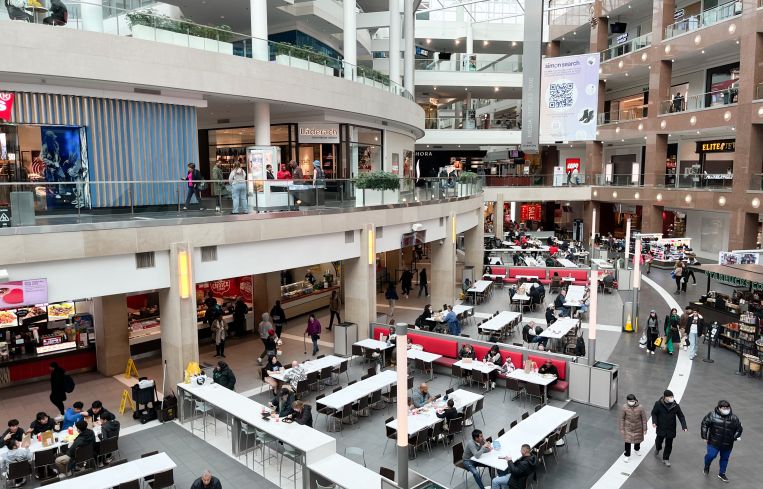Proptech and the Re-Malling of America
Tech’s in the toolbox of brick-and-mortar retailers as they draw customers back
By Philip Russo March 12, 2024 10:00 am
reprints
In an attempt to balance e-commerce versus brick-and-mortar profits, mall owners and retail property tenants are increasingly using proptech to lure back shoppers and reimagine their spaces.
Having realized that e-commerce is often not the most cost-effective way to do business, mall owners and their retail tenants are employing proptech to help support profit-enhancing channels, including foot-traffic tracking, experiential retail, adaptive reuse, online order pickups and delivery, EV charging and more.
“You see in the news that physical retail isn’t going away, but property owners have had to look at some of their portfolio and assets and think about, ‘How do I reuse my existing gross leasable area?’” said Kyle Spencer, co-founder of NextRivet, a San Francisco-based proptech consultancy that works with retail property owners. “Proptech has helped with some of the conversion and reuse of those locations.”
For instance, back-of-the-house shipping hubs are a big issue for retailers, said Spencer.
“When you think about fulfillment, that’s probably the most common or the most influential solution these days, taking existing back-of-the-house operations and converting them to micro-fulfillment or fulfillment solutions, because, for the retailers, replenishment and ship-from-store becomes more and more important for the survival of their industry as a retailer,” he said.
Retailers attempting to replenish inventory and fulfill same-day delivery or e-commerce orders from their physical properties have found such tasks very expensive.
“We see a lot of property owners looking at back-of-house spaces or even front-of-house spaces that can be reconfigured for fulfillment use,” Spencer said. “And proptech solutions like Fillogic and other companies are providing solutions for these retailers to better understand their in-house and store inventory.”
Malls are also using proptech to improve the analysis of one their basic metrics of success: foot traffic.
“For the shopping center and property owners, it has never been easier to understand and take actionable insights off foot traffic,” said Spencer. “They used to have the old-school door counters. But, certainly in the last 10 years, with some of the spatial analytics solutions that are out today using AI and machine learning, it’s essentially taking massive amounts of data on the movement of people.”
Such camera-based customer analytics is not about using facial recognition technology to invade consumers’ privacy, he said. Rather, it is the anonymous tracking of bits and bytes in a data set, allowing the mall owner to understand where people are traveling and when they’re crossing the threshold from the common mall into a particular retail space.
“Understanding that has so many implications for the shopping mall and it’s easier than ever to do this, because you’re taking existing cameras that you might have been using for security for the last 10 years and putting a software layer on top of that,” said Spencer. “You don’t have to put in beacons, you don’t have to put in special hardware. You just use your existing hardware and analyze that data in the video with new software solutions to understand traffic patterns.”
Proptech software providers are aiding brick-and-mortar in three basic areas, said Cederick Johnson, senior director of brand and communications for MRI Software.
“Number one, and this is where MRI probably plays the biggest role, is through the insights and data analytics that retailers can adopt to help them understand consumer and customer behavior, which allows them to deliver more personalized promotions and experiences for the people that actually want to come back to their stores,” said Johnson. “Another trend that we’ve seen in the past several years is retailers really diving into this more immersive experience in their physical locations. And that’s just something that online digital locations really can’t compete with.”
Such experiences range from interactive displays to retailers bringing technology like virtual or augmented reality into the physical location, he said. “And you’ve seen some really cool brands like Nike and Samsung do that at some of their locations, or even focusing on event-led experiences, which is something Apple does a great job of.”
Retailers also can adopt location-based strategies to help them target promotions to customers in their specific area. That includes using smart technologies such as dynamic lighting that enhances or creates a certain atmosphere within the store, making for a more immersive experience, Johnson said.
Mixed-use locations containing retail are increasingly finding technology a necessity, said David Fuller-Watts, CEO at Mallcomm, a Bury Saint Edmunds, U.K.-based platform that has expanded to the U.S.
Mallcomm provides management services for “any destination that has retail at the heart of it,” including airports, train stations, stadiums and other mixed-use facilities, said Fuller-Watts. “It’s a mobile app and website-based platform that anybody who has a relationship to that place or destination or building can get access to information that’s relevant to them.”
Location and design is playing a larger role than ever in mixed-use retail, Fuller-Watts said.
“I think one of the big changes we’re seeing across the world is out of redevelopment projects that are happening and becoming much more mixed-use than just pure straight retail or office,” he said. “There’s a lot of projects that we work on, which involve redevelopment to build residential towers or multifamily, or hotels and leisure destinations, where people can build relationships. Balance and well-being is all very important now. So making sure that we can create places where people want to spend time, that’s the priority.”
Whether involving the redevelopment of a mall or ground-up construction, such mixed-use destinations are responding to consumer demands for more affordable housing, as well as to people who work from home or close to the office, said Fuller-Watts.
“Creating mixed-use environments is certainly going to continue in our view and that’s where our technology really shines,” he said, “because if you’re somebody who lives on the property, you might need different pieces of technology than someone who works in a shop, who’s the landlord, or a corporate retailer who’s never actually on the property but has a real interest in the success of that retail store.”
The desire for sustainable retail locations, combined with the need to attract consumers, has made EV charging an important amenity for owners, said Regan Hartley, director of global real estate at Xeal, a Manhattan-based national EV charging technology for apartments, condos and workplaces. Xeal has developed what it calls the world’s first and only self-reliant connectivity protocol for smart devices, said Hartley.
“When it comes to retail, malls, shopping centers, I think the biggest misconception with charging stations is that you just go to a DC fast charger or you just charge at home,” said Hartley. “Think about charging your vehicle just like you would your phone. So, when you get to 50 percent or lower on battery and you know you’re going to be next to a plug for an hour, you plug it in. Same thing when it comes to a vehicle. So human behavior is now a little bit different, and I think it’s a great way to bring that new wave of drivers to the establishment by offering this as an amenity.”
Malls currently account for about 10 percent of Xeal’s business, but Hartley said she has begun to see a big uptick in retail and commercial locations in general. That makes managing installations an issue.
“I always say you don’t want to build a church for Easter Sunday,” she said. “You want to be mindful with regards to how many stations you actually put in right out the gate to show a significant ROI. But on the other side of it, if you build it, they will come.”
As retail, malls in particular, continue to check out proptech in broader and deeper ways, tech providers are predicting greater demand from the sector’s owners and tenants.
“If you thought proptech was efficient and helping your business as a property owner before,” said NextRivet’s Spencer, “the next two years, and probably the next 18 months, you’re going to see this explosion of better and faster things using AI around those exact same solutions.”
Philip Russo can be reached at prusso@commercialobserver.com.


